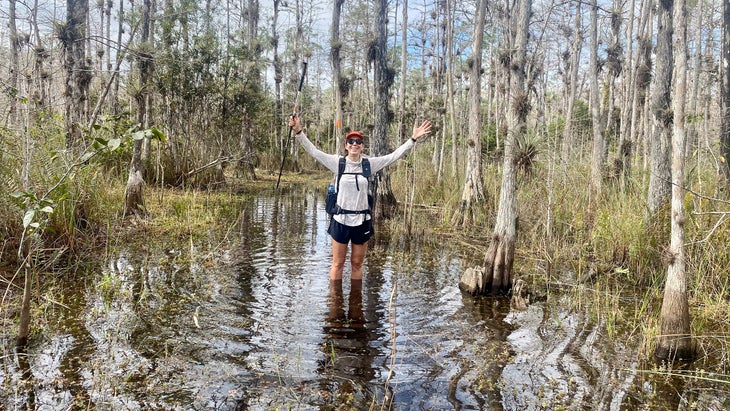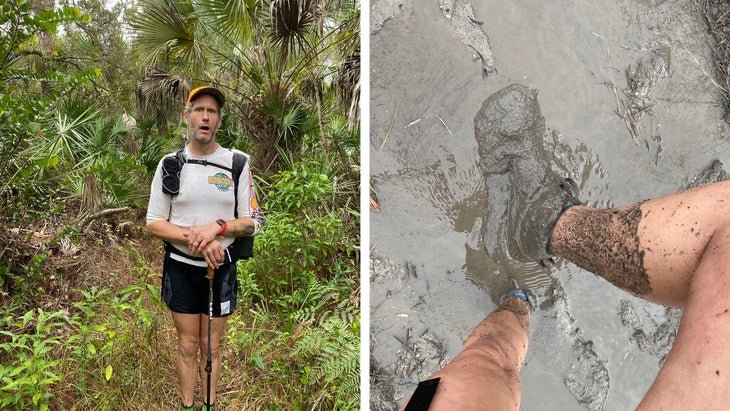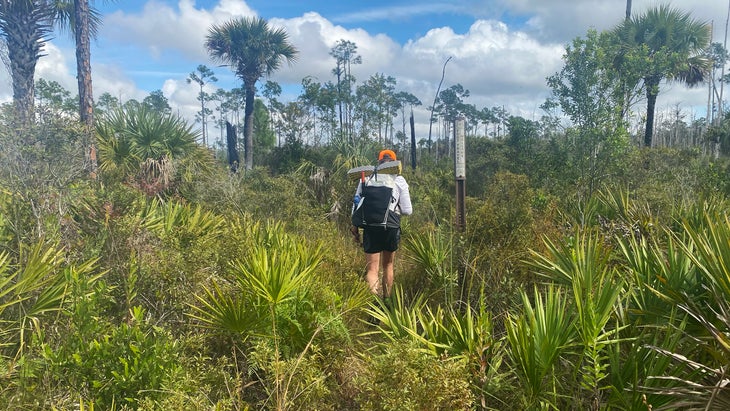Products You May Like
Get full access to Outside Learn, our online education hub featuring in-depth fitness, nutrition, and adventure courses and more than 2,000 instructional videos when you sign up for Outside+
Sign up for Outside+ today.
Fellow hikers invariably laughed when I told them I was going to tackle the Florida Trail early this year. Some friends had vowed never to make the 1,100-mile trek, which is infamous for long walks on asphalt, startling wildlife encounters, and dogs that love to give chase. Those who had done it chuckled and sighed before recalling “the swamp”—the 30-mile stretch through water at the trail’s southern start, often labeled one of the toughest hikes in the United States. I might hate it, they told me.
Undeterred, I set out last month with my wife, Tina, from the trailhead due west of Miami, at the edge of the Everglades and a swampy expanse called Big Cypress. After 15 minutes on the trail, I came to understand what the veterans had warned of: during the first mile, the trail hooked right around a tiny airport, then wound left through a footpath of standing water—the safe artery of earth suddenly hidden beneath stewing brown mud. Tina and I looked for a route around the muck to no avail. Teeth gritted, we plunged ahead. Soppy dirt spattered our clean clothes and caked our shins as we pushed through the morass.

For two days, our slog only intensified. Billowing prairie grass or burned-out tree hulls offered occasional breaks from the water. In patches that looked like jungle, holes in the limestone made me feel as if I were traversing an alpine boulder field or through Alaskan tussocks. But mostly, the water and trail were one, so we followed the bright orange stripes of paint splashed onto cypress trees, which lead the way through the deep swamp.
The water levels varied with every step, rising from feet to knees to thighs in an instant, then back to shoe-sucking guck. I saw crawfish and frogs but somehow missed the snakes, gators, and spiders that other hikers insisted were there. I frequently fell, smearing the mud on my skin across my clothes while fighting to maintain a measly one-mile-per-hour pace. But we kept trudging until we reached Interstate 75, a spit of dry land with a roadside rest stop; the locals have long called the highway Alligator Alley, as if jeering any hiker’s idea of the oasis. We were caked in brown, tired of moving, and still had 1,070 miles to go.
After this arduous start to our journey, I was, of course, disgusting and exhausted, emerging from the swamp in tatters. Already the trail had beaten me: mud had macerated my toes until they looked like expired ground beef, and mosquitoes had bit at my legs until they resembled pale oblong shanks of pepperoni pizza. The water had created a vacuum around my shoes until their backs cut inch-long gashes into both of my heels, stabbing me anew with every step. I’d slammed one knee against a water-concealed cypress and lashed my hand on the limestone beside it. By the time we reached the interstate, I was a mud-puddle-flecked man spattered with blood.
It sounds terrifying, gross, and torturous. But for me, the suffering also felt like a release. I was exhilarated and inspired, high on the effort and the torment. Jarring pain became existential pleasure, stirring me awake after six intense months of writing (though I hesitate to describe life as a music critic, my career of 20 years, as particularly “intense”). What’s more, my ordinary aches—tendinitis here, a stiff joint there, persistent ailments that irk me every day—had been subsumed by more acute pains. When I escaped the swamp, with my perspective on the banalities of life refreshed, I silently vowed to do it again, and soon.
Strangers and friends ask me all the time why I hike such long distances. My answers are as sincere as they are stereotypical: I like when my body feels and looks like a machine. I like being able to eat whatever I want, to move in silence for hours on end, and to contemplate everything, or nothing. I like the camaraderie of the assorted eccentrics, the respite from a day job, and time spent adventuring with Tina. I like to watch the wild landscape change ever so gradually as I advance, as desert rises to mountain and falls to sea. And as cliché as it may sound, I like hiking in search of self-improvement—better patience, deeper listening, stronger empathy. On foot I have time and space to pursue that.
But in just two days on the Florida Trail, its glut of mud and mosquitoes revealed a less predictable reason I hike that I’d either ignored or suppressed for a long time: I like a bit of pain. Actually, I need it, not only to bring me fully into the present but also to reckon with personal privilege. The start of the Florida Trail supplied that in spades.

Outdoor enthusiasts often extol type-two fun, activities that start innocently enough but then slide off the rails into exhaustion, near-death experiences, and so on. The fun comes after the fact, through jokes about survival stories proffered from the safety of, say, a barstool. To me, thru-hiking is not that. More and more, I find I enjoy hiking because I relish the suffering—being in the painful moments and learning to move beyond them. I find myself leaning into pain, perhaps a drug that offers a perspective and balance I struggle to find elsewhere.
“Y’all are into kink hiking—masochists,” the songwriter Laura Veirs recently quipped when I sent her a picture of Tina wading in the swamps of Big Cypress. Was she ribbing me, I wondered, or simply spotting an appreciation for suffering I had long disregarded in myself?
My process toward this realization actually began just before this trip, while I was listening to writer Leigh Cowart discuss their book Hurts So Good: The Science and Culture of Pain on Purpose. A former ballet dancer who now finds their consensual punishment of choice in BDSM play, Cowart first explores their own masochism before delving into the pain-seeking regimens of others—hot sauces so fierce they make you sweat and swear, runs so long or fast you almost tweak, work days so intense your brain seems like overheated soup.
I nodded knowingly as I listened to Cowart speak, since each of their examples were current or former pastimes of my own (save BDSM, but who’s to say where the quest for pain eventually leads?). Cowart lives not far from me, in western North Carolina, I soon realized, near where the Appalachian Trail exits Great Smoky Mountains National Park. If it’s enthusiasm for pain Cowart sought, I thought, they might visit an area campground during spring to eavesdrop on thru-hikers bound for Maine. Hikers, after all, love to complain; we also love to wallow in the results of our elective masochism, the bruises and cuts and puffy joints. I suddenly understood that I, too, revel in that hurt.
Thru-hiking itself is bound to every sort of privilege. How good must I have it, especially in this country at a moment when socioeconomic disparities are only increasing, to volunteer for months of unpaid suffering? My life—lived on the perch of the ladder of American privilege, as a white, educated, cis middle-class man—is easy.
No kids, no debt, no liens. When I’m not on the trail, I sit in a cabin on a mountain writing about music for my career—music that just shows up in the mail for free, mind you. My arbitrary job often feels so removed from the exigencies of the physical world that I assume I’d be the first sacrifice in a survivalist reality show. Talking Heads singer David Byrne, I often think, was right to ask: How did I get here?
Mindfully experiencing pain allows me to perceive and understand just how little suffering my actual life entails, to see through the scrim of pleasantries and evaluate the core of my being. This suffering reminds me, in a very visceral way, how little hardship I have.
In their book, Cowart repeatedly paints masochism as the quest to feel “Just. One. Fucking. Thing.” For me and hiking, the one fucking thing is pain that sublimates into gratitude for how temporary and voluntary it all is. I’m privileged to be able to choose to hurt, and then to stop—an option many people never have. I strive to not take that for granted.

There will be more of us to come, more kink hikers out for our own blood. Much of the First World is increasingly removed from the realities of physical labor, from the toil it can take on our bodies. In her excellent memoir of what it’s like to work inside Big Data, Uncanny Valley, Anna Wiener lampooned our “fetishized life of no friction,” a kind of end goal for Silicon Valley entrepreneurs striving to erase obstacles from our existence. Where’s the suffering or effort in a life where everything is predicted, distributed, and delivered through algorithms and clicks? For me, at least, suffering on the trail means that the pain and toil tend to crowd out space for convenience. I like to feel the world push back.
A few days ago and several hundred miles north of the Florida Trail’s cruel gambit, in a 54,000-acre sweep of palms and grasses called Kissimmee Prairie Preserve State Park, we awoke to record-low temperatures—just above freezing, a rarity in that part of southern Florida. It was so frigid, in fact, that iguanas were falling from the trees (something these cold-blooded creatures do when they lose their energy and grip). Goose bumps juxtaposed with palm trees and my own visible breath made for a surreal morning scene. We zipped our jackets against the wind and started hiking with the rising sun.
After a half-mile, we stopped, staring across a short wetland span with no way to cross but through it. I took a deep breath and plunged in once again, a symphony of icy needles slashing at my skin. I howled but kept walking until something in my brain inexorably shifted—a relaxation, an acceptance, a peace with pain. For a moment, nothing existed but my relationship with the cutting brown water nearing my waist and consequently flooding my mind. There it was, just one fucking thing.
By evening, the cold fronts had shifted, and the weather had warmed. When we walked into camp ten hours later, it was sunny and almost 75 degrees. David Berman, the late songwriter and a supreme elocutionist of pain, once sang that those are the very conditions when “it feels so good to be alive.” No arguing there, but I actually felt more alive, more present wading in what felt like glacial melt that morning, when the hurt obviated everything but a scream that shifted into a smile.
That’s as valid a reason to hike as any, I reckon—to suffer until you smile, and keep going.
